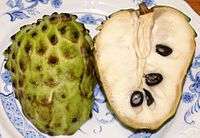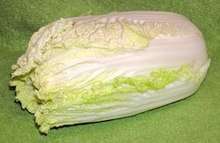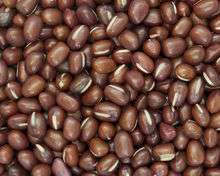Flora of Taiwan
The Flora of Taiwan (Chinese: 臺灣植物誌; pinyin: Táiwān Zhíwù Zhì) is the flora of the country of Taiwan.
Flora of Taiwan is also a set of books recording the vascular plants of Taiwan. The second edition consists of six volumes published in 1993–2003 and is available on-line.[1]
Taiwan is an island of diverse geography and varied climates, allowing for a vast array of flora to be present. Situated between China and the Philippine sea basin, it is said to be the home of approximately 4000 species of vascular plants. Of these plants, it is estimated that 600 are ferns, 28 are gymnosperms, 2400 are dicots, and 1000 are monocots. The island can also be divided up into seven different floristic regions; Northeastern, Central, Hengchun, Lanyu (Orchid Island) and Lutao (Green Island), Alpine, Upper montaine and supalpine, and Lower montane and lowland.
The Northeastern region of Taiwan receives much more rainfall and cloud coverage than other regions, making the species of this particular region distinct to this particular climate. Species of flora within this region include; Isoetes taiwanensis, Fagus hayatae, Maackia taiwaneses, Acer buergerianum var. formosanum, Sedum sekietense, Sedum uniflorum, Angelica dahurica, Angelica hirsutiflora, Rhododendron nakaharai, R. hyperthrum, Rhuchotechum formosanum, Salvia nippocanica var. formosana, Ericaulon chishingsanesis, Woodwardia harlandi, Cinnamomum austro-sinense, Mahonia japonica, Breischneidera sinensis, Triplerygium wilfordii, Lingularia japonica, Enkianthus perulaius, Quercus (Cyclybalanopsis) myrsinaefolia, Acronychia pedunculata, Enscaphis japonica, Lilum speciosum var. gloriosoides, Smilax nipponica, Keteleeria davidiana var. formosana.
The Central region of Taiwan is characterized by basins, and is a plains region mostly surrounded by mountain ranges, such as the Hsueshan Range in the North. The isolated region consists of forests of endemic flora species such as; Castanopsis eyrie, C. kawakami, Quercus dentate, Q. serrata var. brevipetiolata, Lindera aggregate, Podocarpus nakaii, Ormosiaformosana, Wuercus (Cyclobalanopsis) globose, Castanopsis fargesii, Lithocarpus nantoensis.
The Hengchun region of Taiwan is a subtropical evergreen forested area, with broad-leaved forests, as well as a few semi-tropical rain forests in the low-lands. Some of the flora species that can be found here include; Lithocarpus dodanaeifolia, L. shinsuiensis, Quercus (cuclobalanopsis) hypophaea, Q. (c.) repandaefolia, Cinnamomum brevipedunculatum, C. reticulatum, Litsea lii, Machilus abovatifolia, Neolitsea daibuensis, N.hiiransis, Ilex loonicerifolia v. matsudai, Aristolochia kaoi, Asarum epigynum, Acalpha matudai, Euonymus pallidifolia, Dolichos trilobus var.kosyunensis, Gleditsia rolfei, Indigofera byobiensis, Millia formosana, Myrica adenphora var. kusanoi, Piper kawakamii, Reevesia formosana, Symplocos shilanensis, Camellia hengchunesis, Syzygium euphlebium, Syzygium kiskusense, Callicarpa remotiserrrulata.
The Lanyu (Orchid Island) and Lutao (Green Island) regions of Taiwan are the most similar to the Philippines, though the rest of Taiwan is more similar to mainland China. Forty-six of four-hundred and forty five seed-plant species within these two islets of Taiwan are shared with the Philippines, the only region still considered Taiwan that shares species with the neighboring country. Endemic species within this district consist of Cinnamomum kotoense, Murraya paniculata var. omphalocarpa, Chisocheton kanehirai, Acalypha hontauyensis, Exoecaria kawakamii, Cissus lanyuesis, Calopphyllum changii, Garcinia linii, Medimilla hayataiana, Diospyros kotoensis, Alyxia insularis, Trachelospermum lanyuense, Lysionotus ikeadae, and Lasianthus obliquinervis var. simizui.
The Alpine district of Taiwan has distinctly different flora than the rest of the country. The alpine district pertains mostly of boreal and temperate vegetation such as Botrychium lunar, Lycopodium selago appressum, Osmunda cinnamomea, etc.
The Upper montane/subalpine district, similar to the alpine district, is temperate to cool temperate. Conifers are the main vegetation of this region. Abies kawakamii, Tsuga chinensis, and Picea morrisoncola, to name a few, are some of the species that exist within this floristic zone.
The Lower montane/lowland district of Taiwan is more similar to the warm climate forests, supporting broad-leaved forests. Some of the species of the forests common to this floristic zone include; Castanopsis, Quercus, and Lithocarpus.
Agricultural Flora of Taiwan
Cultivated agriculture produced in Taiwan has drastically changed Taiwan's development. Agriculture has become as much a part of the naturally existing flora of Taiwan, and human influence on the land has greatly contributed to the vegetation of the country. Bamboo, Fruits, Grains and vegetable crops all thrive on the island, mostly thriving in the Central, Southern and Eastern regions.
Bamboo has largely taken a hold in the country as a cash-crop. Large areas of Taiwan have been converted into various bamboo plantations. Most of the bamboo is grown to support the developing economy, however the species also provides support to rural communities as its sturdiness provides strength and stands firm in the midst of the high-speed winds that can dominate the country during rainy-monsoon seasons.
Fruit trees typically grow in the low-lands of the island. Western and Southwestern Taiwan is the primary fruit-producing region. Fruit commonly grown in Taiwan are tropical and plentiful including lychees, pengkan tangerines, hseukan tangerines, oranges, bananas, grapes, betel nuts, kaochie pear, plum, peach, starfruit, persimmon, guava, papaya, mango, lemon, Indian dates, pineapples, coconuts, apricots, and loquat.
Grain and Vegetable crops are mainly cultivated in Northern Taiwan. Rice and vegetables are grown in large paddies in the lowlands of the TTa'an river, plains of Miaoli and Hsinchu counties, the Hungli and Taoyen terraces, the Taipei basin, and the Ilan plain. The vegetables grown in these areas consist of kale, mustard, Chinese cabbage, wengtsai, celery, cucumber, yucca, winter melon, pumpkin, eggplant, red bean, peas, tomatoes, radishes, ginger, taro, onion, leek, and garlic. Vegetables are typically planted in rotation with rice, and their seasons do not coincide.
The major agricultural exports from Taiwan include paddy rice, sugar cane, cloud apples, and betel nuts.
Cultural significance
| Title | Symbol | Picture |
|---|---|---|
| State tree | Camphor tree (Cinnamomum camphora) |  |
| State flower | Chinese plum blossom (Floral Emblem of Taiwan) |  |
| State fruit | Pineapple sugar apple (Annona squamosa × Annona cherimola) |  |
| State vegetable | Chinese cabbage (Brassica rapa) |  |
| State crop | Adzuki bean (Vigna angularis) |  |
See also
- Outline of Taiwan
- Category:Flora of Taiwan
- Category:Endemic flora of Taiwan
- Category:Trees of Taiwan
References
- Huang, Tseng-chieng, ed. (2000). Flora of Taiwan (2nd ed.). Taipei, Taiwan: Editorial Committee of the Flora of Taiwan, Second Edition. ISBN 957-9019-52-5.
- Li, Hui-Lin (1963-01-01). Woody flora of Taiwan. Narberth, Pa.,.
- "電子書 台灣植物誌第二版 Flora of Taiwan, 2nd edition 1: 1 - Plants of Taiwan 台灣植物資訊整合查詢系統". tai2.ntu.edu.tw. Retrieved 2017-04-21.
- "||| 臺灣大學數位人文研究中心 (Research Center for Digital Humanities)|||". www.digital.ntu.edu.tw. Retrieved 2017-04-21.
- Notes
- Huang, Tseng-chieng, ed. (2000). Flora of Taiwan (2nd ed.). Taipei, Taiwan: Editorial Committee of the Flora of Taiwan, Second Edition. ISBN 957-9019-52-5.
| Wikimedia Commons has media related to Flora of Taiwan. |